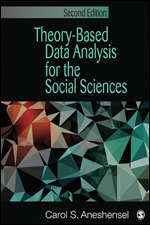Theory-Based Data Analysis for the Social Sciences
- Carol S. Aneshensel - University of California, Los Angeles, USA
Quantitative/Statistical Research (General)
“In clear and accessible prose, this book presents a compelling logic for the analysis of non-experimental data. In the process, it clarifies the concepts of statistical association, confounding, and statistical control, and it provides really compelling elaboration schemes to make substantive, rather than purely statistical, sense of it all. It also provides a means for making causal assertions when the criteria of association, causal priority, non-spuriousness, and theoretical rationale are met.”
“This text does a superb job of explaining critical concepts such as mediation, moderation, spuriousness, and control variable, using graphic illustrations as well as published articles as examples. I think the illustrated examples are really helpful for illuminating these concepts. Furthermore, the majority of empirical research in the social behavioral sciences utilizes regression, logistic regression, and path analysis. The book discusses many empirical articles utilizing these analytic approaches as examples. Thus, the contents of this book are highly relevant and understandable for those in early stages of research training.”
I think this is a very much awaited book. I think it is very well suited for PG level, particularly for those MA students who are writing their dissertations (and PhD students as well). As strange as it may seem, students struggle to understand what theory is and how it relates to data. For me this book engages comprehensively in these questions. There is a good discussion of how to work with variables, about the construction of associations and causalities. I wish I could teach more of this book in my MA course, but due to time constraints I would definitely recommend Chapter 1-4 (where the focus is on conceptual discussion). The book is very helpful for those constructing and designing their research. The book is not the ‘beginner level’. It would be helpful if students already have some background in quantitative analysis, therefore I would not, however, recommend for BA level.
I think this is a very much awaited book. I think it is very well suited for PG level, particularly for those MA students who are writing their dissertations (and PhD students as well). Students often struggle to understand what theory is and how it relates to data. For me this book engages comprehensively in these questions. There is a good discussion of how to work with variables, about the construction of associations and causalities. I wish I could teach more of this book in my MA course, but due to time constraints I would definitely recommend Chapter 1-4 (where the focus is on conceptual discussion). The book is very helpful for those constructing and designing their research project. The book is not a ‘beginner level’ though. It would be helpful for students who already have some background in quantitative analysis, therefore I would not, however, recommend for BA level.
The prose is too dense for the typical master's degree student. Probably suitable for doctoral students.
This will be my first year using the second edition. I have used tthe first edition for several years. I am a bit concerned that the second edition will overlap with DeVellis. This book has been ordered for Fall 2013
Wonderful Text... Dr. Aneshensel makes multivariate analysis sensible and connected to theoretical propositions in a way I have not seen before.

